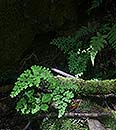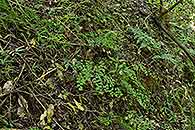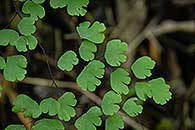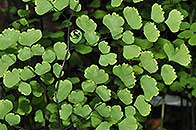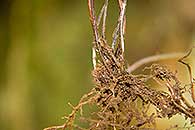Adiantum poiretii J.E. Wikstr.
Synonyms |
Adiantum crenatum Poir. |
|---|---|
Common name |
|
Description |
Rhizome widely creeping, c. 2 mm in diameter; rhizome scales appressed, lanceolate in outline, apex gradually tapering to a point, slightly ciliate, up to 8 × 0.8 mm, brown. Fronds monomorphic, closely spaced or frequently tufted at the end of the rhizome, arching to erect, herbaceous, glabrous. Stipe up to 35 cm long, dark brown to black, shiny, glabrous save for brown lanceolate scales at the base. Lamina 2-4 pinnate, branching irregular, broadly ovate-deltate in outline, 30 × 25 cm; pinnules deciduous, semicircular to triangular in outline, base truncate to rounded, bluntly toothed on the outer and upper margin, 0.5-1.5(-2) × 0.5-1.5(-2.2) cm, veins ending in the sinuses of the lobes of the outer margin, hairless; rhachis and stalks black, shiny, hairless, stalklets 2-5 (-7) mm long, brown, hairless. Sori 1-6, on the undersurface of the pinnules situated in the marginal sinuses, indusial flap rounded-oblong to crescent shaped, up to 2.5 mm long, hairlesss, sometimes surrounded by some yellow powder. |
Notes | A. poiretii is 2-4 pinnate. It may be confused with A. capillus-veneris which has the veins ending in the teeth of the marginal serrations. A. raddianum has much smaller pinnules and almost circular shaped sori. The pinnules of A. poiretii are also deciduous. |
Derivation | poiretii: named after Jean Louis Poiret (1755-1834), French botanist. |
Habitat | In moist evergreen forest or medium-altitude riverine forest. |
Distribution worldwide | Africa, Indian Ocean Islands, India, Tristan da Cunha, tropical America. |
Distribution in Africa |
Angola, Benin, Burkina Fasso, Burundi, Cameroon, Central African Republic, Chad, Congo, Dem. Republic of Congo, Equatorial Guinea (incl. Bioko), Ethiopia, Ghana, Guinea, Guinea Bissau, Ivory Coast, Kenya, Liberia, Malawi, Mali, Mozambique, Niger, Nigeria, Rwanda, Senegal, Sierra Leone, South Africa, Sudan and South Sudan, Swaziland, Tanzania , Uganda, Zambia, Zimbabwe. |
Growth form |
Lithophytic, terrestrial. |
Literature |
|
